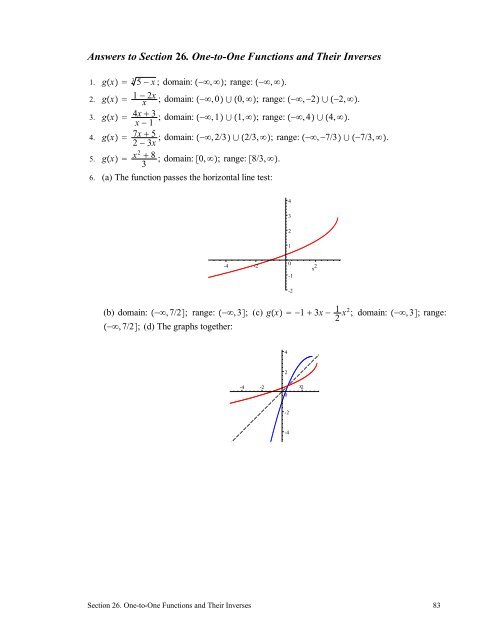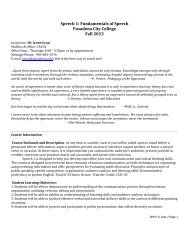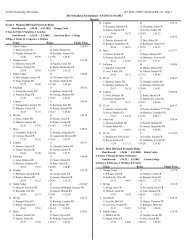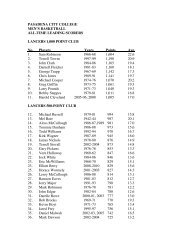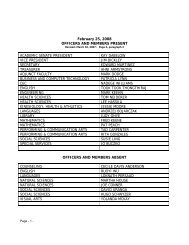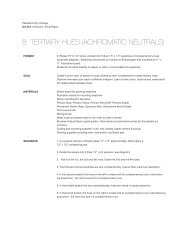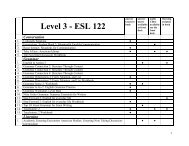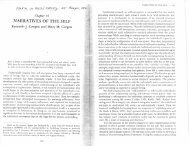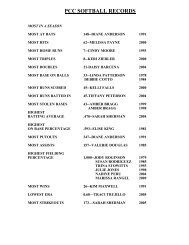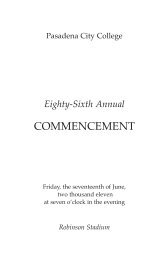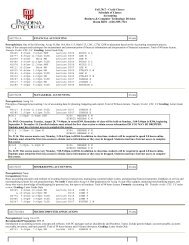Answers to Section 26. One-to-One Functions and Their Inverses
Answers to Section 26. One-to-One Functions and Their Inverses
Answers to Section 26. One-to-One Functions and Their Inverses
Create successful ePaper yourself
Turn your PDF publications into a flip-book with our unique Google optimized e-Paper software.
<strong>Answers</strong> <strong>to</strong> <strong>Section</strong> <strong>26.</strong> <strong>One</strong>-<strong>to</strong>-<strong>One</strong> <strong>Functions</strong> <strong>and</strong> <strong>Their</strong> <strong>Inverses</strong><br />
1. gx 3 5 x ; domain: , ; range: , .<br />
2. gx 1 x<br />
2x<br />
3. gx 4x x 1 3<br />
; domain: , 0 0, ; range: , 2 2, .<br />
; domain: , 1 1, ; range: , 4 4, .<br />
4. gx 7x 2 3x 5 ; domain: , 2/3 2/3, ; range: , 7/3 7/3, .<br />
5. gx x2 8 ; domain: 0, ; range: 8/3, .<br />
3<br />
6. (a) The function passes the horizontal line test:<br />
4<br />
3<br />
2<br />
1<br />
-4 -2<br />
0<br />
x<br />
2<br />
-1<br />
-2<br />
(b) domain: , 7/2; range: , 3; (c) gx 1 3x 1 2 x2 ; domain: , 3; range:<br />
, 7/2; (d) The graphs <strong>to</strong>gether:<br />
4<br />
-4 -2 x2<br />
0<br />
2<br />
-2<br />
-4<br />
<strong>Section</strong> <strong>26.</strong> <strong>One</strong>-<strong>to</strong>-<strong>One</strong> <strong>Functions</strong> <strong>and</strong> <strong>Their</strong> <strong>Inverses</strong> 83
7. (a) the graph is a complete parabola facing up, so it does not pass the horizontal line test; (b)<br />
fx is one-<strong>to</strong>-one on 3, ; (d) gx 3 1 2x 10 ; domain 5, ; range: 3, . The<br />
2<br />
graph of fx restricted <strong>to</strong> 3, is in red, <strong>and</strong> the graph of gx is in blue:<br />
12<br />
10<br />
8<br />
6<br />
4<br />
2<br />
0<br />
2 4 6 8 10 12<br />
x<br />
8. (a) the graph is a complete parabola facing up, so it does not pass the horizontal line test; (b)<br />
fx is one-<strong>to</strong>-one on , 8/3; (d) gx 8 3 1 6x 14 ; domain 7/3, ; range:<br />
3<br />
, 8/3. The graph of fx restricted <strong>to</strong> , 8/3 is in red, <strong>and</strong> the graph of gx is in<br />
blue:<br />
10<br />
8<br />
6<br />
4<br />
2<br />
-2<br />
0<br />
2 4 x 6 8 10<br />
-2<br />
9. (a) f / x 3x 2 5 5 0, so fx is mono<strong>to</strong>nic increasing for all reals, hence 1-1. (b) By<br />
trial <strong>and</strong> error, g 9 1 <strong>and</strong> g 15 2. (c) g / 9 1<br />
f / 1 1 <strong>and</strong><br />
8<br />
g / 15 1<br />
f / 2 17 1 .<br />
10. (a) f / x 3x 2 12x 15 3x 2 4x 4 4 15 3x 2 2 3 3 0, so fx is<br />
mono<strong>to</strong>nic increasing for all reals, hence 1-1. (b) By trial <strong>and</strong> error, g 17 2 <strong>and</strong><br />
g 19 1. (c) g / 17 1<br />
f / 2 1 3 <strong>and</strong> g / 19 1<br />
f / 1 30 1 .<br />
11. (a) f / x 2 sinx 5 3 0, so fx is mono<strong>to</strong>nic decreasing for all reals. (b) The 5x<br />
term should give you a hint that g 5/2 /2 <strong>and</strong> g 15/2 3/2. (c)<br />
g / 5/2 1<br />
f / /2 3 1 <strong>and</strong> g / 15/2 1<br />
f / 3/2 3 1 also.<br />
12. (a) f / x 14 12 cos4x 2 0, so fx is mono<strong>to</strong>nic increasing for all reals. (b) The<br />
14x term should give you a hint that g 7 /2 <strong>and</strong> g 7/2 /4. (c)<br />
g / 7 1<br />
f / /2 1 2 <strong>and</strong> g / 7/2 1<br />
f / /4 26 1 .<br />
<strong>Section</strong> <strong>26.</strong> <strong>One</strong>-<strong>to</strong>-<strong>One</strong> <strong>Functions</strong> <strong>and</strong> <strong>Their</strong> <strong>Inverses</strong> 84
13. (a) f / x 2 3 2 0, so fx is mono<strong>to</strong>nic increasing on 0, . (b)<br />
2 x<br />
f 1 x 1 2 x 9 8 3 8x 9 . Finding this is a bit tricky. First solve for y with the<br />
8<br />
3 8x 9<br />
quadratic formula, <strong>and</strong> we get y . To make sure that y is positive, we<br />
4<br />
pick the choice. Squaring both sides gives us f 1 x. (c) Since fx is mono<strong>to</strong>nic increasing<br />
on 0, <strong>and</strong> obviously increases without bound, <strong>and</strong> f0 0, the range of fx is also<br />
0, . Thus, the domain of g x is 0, , <strong>and</strong> the range is also 0, .<br />
(d) g / x 1 2 3<br />
2 8x 9 , so g / 14 <br />
11 4 . (e) g 14 4.<br />
(f) g / 14 1<br />
f / 4 1 <br />
2 3<br />
4 , as expected.<br />
11<br />
2 4<br />
<strong>Section</strong> <strong>26.</strong> <strong>One</strong>-<strong>to</strong>-<strong>One</strong> <strong>Functions</strong> <strong>and</strong> <strong>Their</strong> <strong>Inverses</strong> 85


